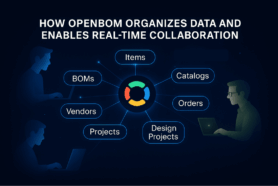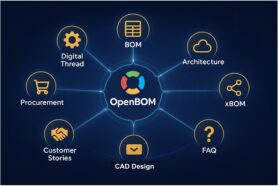
BOM is the foundation of everything in product development and manufacturing. It has always been the case, however, BOM was usually downplayed as a simple spreadsheet with a list of parts. While there is nothing wrong with the list of parts, modern manufacturing environments bring many questions and issues that require us to rethink our view on what is Bill of Materials and how modern manufacturing companies should manage it.
This week, I will be sharing with you a set of articles that will help you to better understand the broader scope of BOM Management and the role BOM information has in building modern SaaS software for engineers and manufacturing companies.
Talking to many customers over the last few months, we found out how critical the Bill of Materials is for them. Today, I want to start from the list of issues that gives you a broader understanding and perspective on the role of the Bill of Materials and proper ways to manage them.
Part List vs Product Details And Manufacturing instructions
A simple list of parts with their manufacturer part numbers and corresponding quantities can be good enough for simple tasks – purchasing parts, but it is very quickly necessary to bring more information. In such a way managing part numbers properly is the first and most important step. Using manufacturer part numbers is easy, but as soon as you try to change the manufacturer, your BOMs will require re-work. Not using property Part Numbers and relying on the description is a sin I often see with many companies, which usually ends up with the disaster of manual re-work and losing traceability in product data.
Another place where the absence of proper BOM information will be killing your product design, manufacturing, and customer experience is manufacturing instructions and documentation. How often have you gotten a product with instructions (let’s say it politely) that doesn’t reflect what you have in a box? Tools and production planning, manufacturing instructions, and many other pieces of documentation are absolutely important and a simple excel BOM is clearly not enough to manage it.
Supply Chain Shortage
The theme of shortage of electronic components and other supply chain challenges are everywhere these days. This is a huge issue for many companies. Procurement teams are working hard, and helping them can be a good idea. The problem is that vendors are not necessarily making it easy to swap components to alternative suppliers. A well-organized product information system, access to online data sources, and well-documented requirements can be very helpful for the procurement team to find alternatives and many more tasks. Relying on multiple Excel spreadsheets, in this case, would be a bad idea.
Regulation, Compliance, and Traceability
In a global market, manufacturing goes beyond just the assembly of a product and selling it in a local store. Modern manufacturing is competitive, including many regulations and requirements that must be followed. It requires information and organization of data beyond the simple spreadsheet. How can you get all the needed information to certify the product is compliant with specific regulations? In case of any problem, how can you bring a historical BOM to know what information, components, and suppliers are used for a specific product that currently exists and is used by a customer?
BOM as Team Work
Product development goes through multiple stages and it is teamwork that ensures that multiple elements of the product fit together and you’re not missing anything. Modern teams are located in multiple places and have responsibilities for different pieces of information. So, How do you bring it all together? Sending excel or sharing Google Sheets can be a bad idea. I’ve seen how it leads you to lose the information and copy/paste many pieces of data between multiple spreadsheets.
Teamwork is hard when you don’t have the right tool. You better have tools that allow you to seamlessly share the data between the users based on the role access and allows you to edit information simultaneously to ensure your team is “on the same BOM”.
Conclusion
Bill of Materials (BOM) was born as a simple list out of an immediate necessity, but modern manufacturing companies’ needs have outgrown the simple lists. If you rely on a simple spreadsheet, you put yourself in a disadvantageous position compared to your competitors and in many cases risk your company’s business future by not following the regulation and compliance requirements.
Don’t bet your future on spreadsheets and check out how OpenBOM can help you. OpenBOM is a modern tool that helps you manage data, including full product information, bill of materials, files and stay connected with your team using a unique set of collaboration capabilities and tools.
Check out what OpenBOM can do for you – REGISTER FOR FREE and start a 14-day trial to check out all of our functions.
Best, Oleg
Join our newsletter to receive a weekly portion of news, articles, and tips about OpenBOM and our community.










